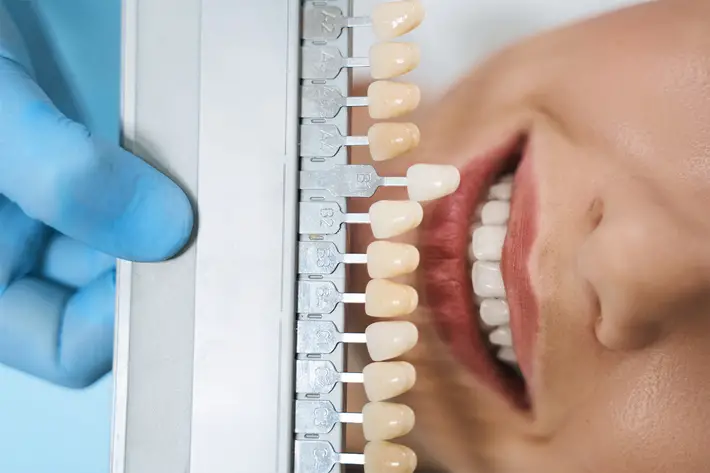Veneers vs Crowns

Many people think that because veneers and crowns have the same function, they are the same things. However, they have a lot in common as well as a lot of differences. They both help improve the teeths’ look, aesthetics, and health.
To help you discover which dental restoration is best for you, here is a glance at the differences when each method is be used, and which you should go for.
To understand each better, we need to know what veneers and crowns mean.
What Are Veneers?
Porcelain veneers are made of thin layers of fine, stain-resistant dental porcelain. They are usually a few millimetres thick. Veneers are made to cover the front tooth of each patient.
To prepare your tooth for porcelain veneers, dentists like those in Dentakay Dental Clinic have to grind about half a millimetre of enamel on the front of your teeth to make it easier to stick together. Aesthetics might be required because of the grinding.
It should be noted that veneers can be fixed on a tooth with plenty of enamel.
What Are Crowns?
Dental crowns completely cover the whole teeth. This means more teeth will be filled with enamel before dental crowns can be fixed onto them. Crowns are used to restore damaged teeth, decayed teeth, and fractured teeth.
If your teeth are decayed and you need to use a dental crown, you will need to remove them and replace them with built teeth so they can support the dental crown.
Dental crowns are usually made from porcelain fused to a metal or an all-metal alloy. Your dentist will then make his crown to the size of your mouth and glue it to the teeth.
Veneers Vs. Crown: Similarity
The veneers vs crown debate didn’t just happen as you can also see in this article Veneers vs Crowns: Costs, Similarities, and Differences. People do not just assume that dental veneers and crowns are the same. The cause of this confusion is based on the fact that crowns and veneers have some similarities.
Some similarities between veneers and crowns include the following.
● Both dental crowns and veneers enhance the looks and function of the teeth.
● They are used to restore teeth that have been cracked, damaged, decayed, broken, or coloured.
● Veneers and crowns are made to match the colour of your initial teeth.
● Once a veneer and crown are applied, it isn’t easy to differentiate them because it has the same effect on your smile.
● You must brush twice daily for both a veneer user and a crown user to remove food practices and stains.
● Both veneer and crown users must visit their dentist to check the restoration and for skilled cleaning.
Veneers vs Crowns: Differences
There have been several veneers vs crowns debates, with some people thinking that veneers and crowns are the same things, while others are of the opinion that they are two different things.
Dental veneers are quite different from dental crowns, and here are a few differences;
| Veneers | Dental Crown |
| A porcelain veneer is fixed to the outer surface of your tooth. | A dental crown is bonded to cover the whole of your tooth. |
| Veneers can be replaced after 5- 10 years. | A dental crown may be able to last for 20 years and more. |
| Veneers are not as thick as a dental crown. It is a very thin layer of about 1 millimetre in thickness. | Dental crowns are always thicker. Crowns are about 2 millimetres thick. |
| The gum of the teeth is obvious because it covers only half of the teeth. | Less gum is shown because it covers the whole of the teeth. |
| Porcelain veneers cost $925 to $2500 per tooth. | Dental crown ranges from $1000 to $3500 per tooth. |
Veneers vs Crown: Best choosing Policy
To help you determine which is best for between veneers vs crowns, we will be giving you tips on what to consider before choosing any of the two.
No doubt that both veneers and crowns serve the same purpose but can they be used interchangeably? No, they can’t. A dentist is in the best position to decide the best according to your situation.
Since enamel is more compromised, dental crowns are best for damaged, decayed, or holes in teeth, while porcelain, on the other hand, is best for cosmetic appearances. If your teeth are intact but need a little correction or a small crack, your dentist is likely to recommend porcelain veneers.
Veneers Vs. Crowns: Cost
Veneers and crowns can be costly and are mostly depending on the size of your tooth and where it needs to be fixed.
Most dental insurance programs don’t cover expenses for cosmetic appearances and have an annual coverage limit.
Veneers
According to the American Dentist Organisation, they cost $925 to $2500 per tooth.
Dental Crowns
The cost of crowns varies from different material to be used. According to the consumer guide, dental crowns range from $1000 to $3500 for a tooth.
Porcelain and ceramic dental crowns tend to be more expensive than all-metal crowns.
What Are The Benefits And Drawbacks Of Veneers and Crowns?
Veneers pros
● Teeth with veneers have minimal movement.
● Veneers don’t require a lot of trimming; therefore, most of your natural tooth remains intact.
Veneers cons
● Veneers endanger your tooth to new decay as they do not cover all the teeth.
● They do not cover dental insurance.
● Veneers can’t be reversed.
Crowns pros
● All the teeth are covered, which helps protect them from any new decay.
● They look real and make your teeth feel natural.
● Dental insurance covers a part of the expense.
Crowns cons
● Most of your teeth are removed to make space for the crown to be fixed.
● Crowned teeth are sensitive to heat and cold, and pain can often result from the gum. If any of this occurs, it is advisable to visit the dentist.
Conclusion
Are you discouraged about your teeth and ready to improve your self-esteem? Wondering which is best for you, veneers vs crowns?
Now you know that veneers and crowns are used to enhance your smile and the function of the teeth. Reach out to your dentist today, don’t forget your regular checkups, and practice good dental hygiene, which is vital.










